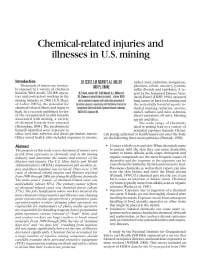Mining Publication: Chemical-Related Injuries and Illnesses in U.S. Mining
Original creation date: July 2009
Authors: DF Scott, EM Merritt, AL Miller, PL Drake
The purpose of this study was to determine if miners were at risk from exposures to chemicals used in the mining industry and determine the nature and sources of the illnesses and injuries. The U.S. Mine Safety and Health Administration's (MSHA) employment and accident, injury and illness database was reviewed. There were 2,705 cases of chemical-related injuries and illnesses reported from 1999 through 2006, involving 66 different chemicals. The main source (cause) of chemical-related cases was acids/alkalis (about 39%). The primary nature (effect) of chemical-related cases was chemical burns (about 57%). The job classification where workers incurred the most chemical-related injuries and illnesses was cleaning plant operator/media operator/boney preparation plant operator/crusher worker (cleaning plant operators are responsible for maintenance of plants, media operators are responsible for handling reagents, boney preparation plant operators oversee removal of "bone" from coal, and crusher workers use large crushers to break mined material). From 1999 through 2006, the rate of "nonfatal days lost" and "no days lost" (resulting from injuries) did not change significantly; however, the rate of illnesses decreased significantly. Chemical burns accounted for a large number of injuries; mining companies should carefully examine their personal protective equipment (PPE) requirements, training methods and safety culture to ensure that their workers are protected.

- Analysis of Practical Ground Control Issues in Highwall Mining
- Economics of Safety at Surface Mine Spoil Piles
- Guidelines for Instructional Materials on Refuge Chamber Setup, Use, and Maintenance
- Preventing Equipment Related Injuries in Underground U.S. Coal Mines
- Random Motion Capture Model for Studying Events Between a Machine and its Operator
- Safety Considerations for Transport of Ore and Waste in Underground Ore Passes
- Using Fault-Tree Analysis To Focus Mine Safety Research